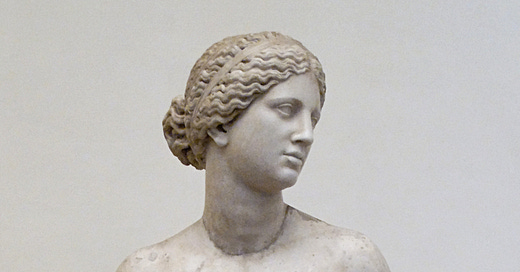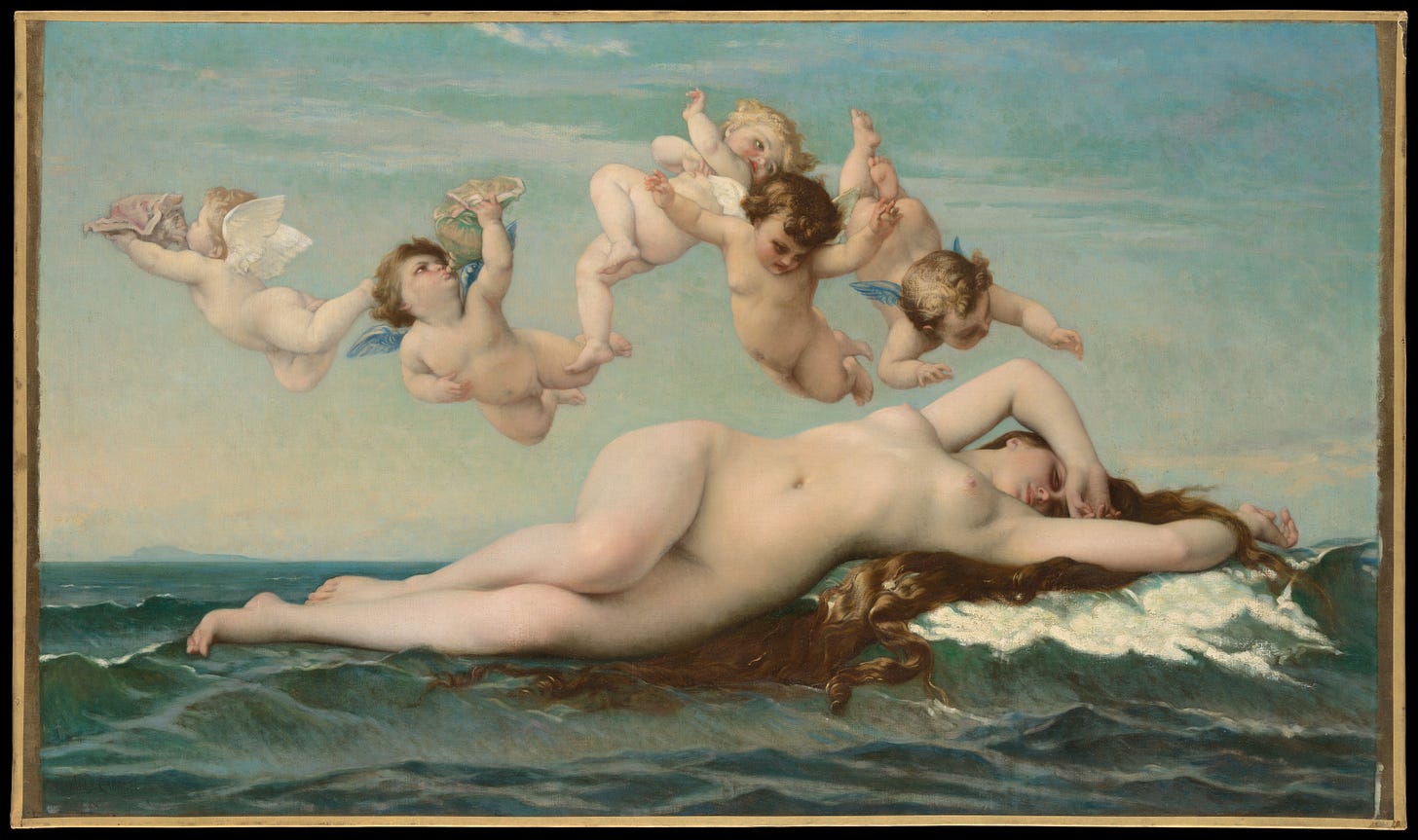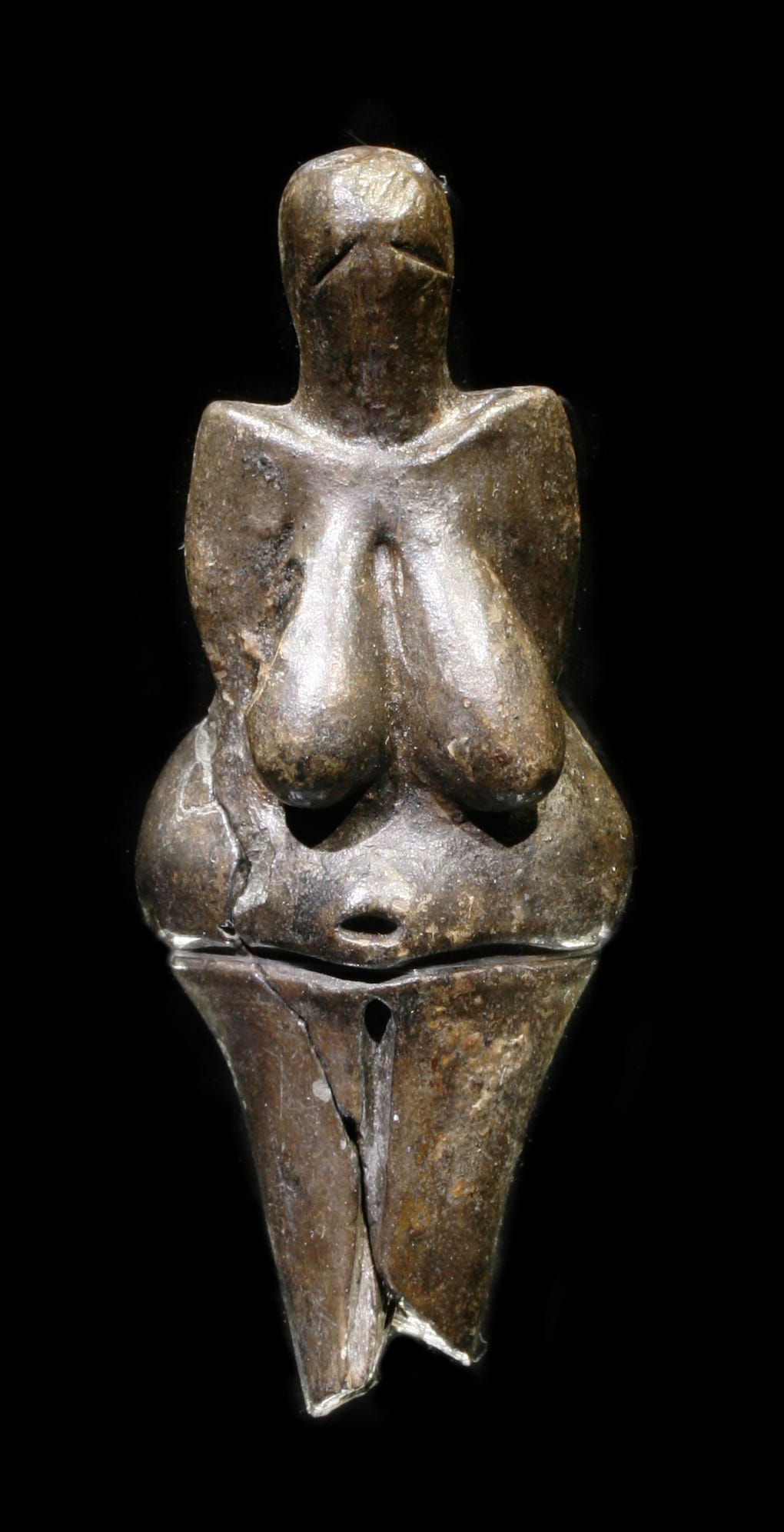Scandalous nudity: the ancient version of getting kicked out of the grammys
The Aphrodite of Knidos = a sculpture that was so sexy it was rejected by its initial recipients
Okay I have a problem. I am seriously so desensitised by nudity I don’t even see it. Truly, I barely notice it and I’ve been saying for YEARS that it is because of my love of ancient sculptures. I’ve looked at hundreds, a real slew over the years, and everyone’s got their bits out. I genuinely forget that nudity, especially within an artistic context, can still be controversial or distasteful for some people (luckily Zuckerberg continues to remind me as I get put in Instagram jail every time I upload something with a marble nipple). As those of you that have been around for a while may remember, I’ve also hosted clothing-free events (and I also went to boarding school which can’t have helped matters).
My point IS, even I was a bit taken aback by what went down at the grammys a week ago. For those of you that missed it, the TLDR: is Kanye’s wife, Bianca Censori, rocked up fully naked.
Okay technically not FULLY naked but you see what I mean. The internet responded much as you’d expect (her last name is literally censor-i, I feel like people should be having more fun with that), with responses ranging from disapproval, horror, and celebration. I did see one very good TikTok which had a great take about how pubic hair would’ve made this a much more successful look.
 Tiktok failed to load.
Tiktok failed to load.Enable 3rd party cookies or use another browser
Part of the online response has been raising some very important points about consent, agency, and racism — while we know that Kanye historically is quite controlling when it comes to what his partner wears, would he face such scrutiny as a white guy? How does his very public mental health crisis come into it? Would the whole thing be less alarming to the general public if Censori didn’t look completely dead behind the eyes? Is full frontal nudity at a public, red-carpet event ever remotely appropriate? Would it have gone down differently if Kanye was the one in the sheer slip?
All excellent questions and I plan on answering none of them. Except for the last one. Which is a bit of a cop-out as the answer is glaringly obvious.
The way we feel and think about nudity is split down a gendered line. I’m not even going to bother arguing or belabouring that point as it is remarkably self-evident. I do want to talk about naked women though. One in particular, the Aphrodite of Knidos, who happens to be made of marble.
Strap in.
Praxiteles, a famed Athenian sculptor, created this monumental masterpiece depicting the Greek goddess of love and sex in the 4th century BCE. The sculpture is complete with an ineffective, somewhat counterproductive gesture of modesty as the hand placed over her pubic area pulls your eyes to that very spot. Praxiteles even gives his goddess an alibi for her nudity in the form of a water jug (the goddess is either about to begin or finish up bathing). The sculpture plays with voyeurism and the eroticisation of taboo marvellously.
Unfortunately the original statue is no longer with us BUT thanks to the Romans, your favourite ancient copycats, we’ve got about 130 reproductions floating around so more than enough to work with.
Pliny, writing centuries after its creation, describes how people would sail from all over the place to come and visit the sculpture. The story goes that Praxiteles sculpted two Aphrodites, one clothed (or, more accurately, draped) and one fully naked. He offered the sculptures to the ancient residents of the islands Kos and Knidos, with Kos getting first dibs. Kos picked the draped, demure model while the Knidians accepted the spicier version gladly (presumably). It was so lucrative as a visitor attraction that when King Nikomedes tried to buy it off the Knidians, offering to get rid of the huge pile of debt they’d accumulated, the Knidians refused. They kept the statue and kept raking it in.
The ancient Greeks came to the ground-breaking, earth-shattering realisation that sex sells.
Another bit of ancient evidence tells an even more scandalous story. The text is titled Erotes (meaning ‘Loves’ or ‘Affairs of the Heart’) and is possibly/tentatively attributed to Lucian, a Greek writer working in the second century AD. He describes the now infamous visit to Knidos, where two men see the statue, and the straight one immediately starts kissing it. They move around the statue, taking in the whole view, and when the not-so-straight Athenian clocks her backside he’s thrilled, exclaiming that her ass is that of a young boy’s. Regardless of sexual orientation, they’re both in awe thanks to the power of the goddess and the skill of the sculptor.
The visitors spot a small stain on Aphrodite’s marble ass, thankfully a priestess is there to give them the lowdown. She describes how a visitor fell desperately in love with the statue, locked himself in the temple overnight, and, in the words of scholars far more delicate than me “attempted to consummate his passion.”
So. He fucked the statue.
When he was discovered, he was so ashamed he flung himself off a cliff into the ocean (possibly to be reunited with the goddess once more as she was born from the sea but I really am speculating here).
There are a also bunch of ancient epigrams (short poems) found in a book of Byzantine poetry known as the Planudean Anthology. There are twelve that talk about our Aphrodite and they all focus on one question, asked by the goddess:
“How the hell did Praxiteles manage to see me naked?”
All this to say that this sculpture was a) scandalous b) pretty realistic and c) VERY famous — it made it into a wide range of literary sources, was found on ancient coins, and was copied hundreds of times (if we’ve still got 130, imagine how many were floating around back in the day).
You may be wondering what’s the big deal, you might even be preparing a multi-sentence comment reminding me of the MANY other examples of nude female figures that pre-date the Aphrodite of Knidos. And you’re absolutely right. We do have earlier ancient sculptures that show the naked female form in all its glory. Figurines of Astarte, the even more ancient antecedent to Aphrodite, don’t exactly shy away from nudity. And before THAT, we have all those gorgeously plump ladies that scholars are fond of slapping a “fertility figurine” label on.
What’s more, Zeuxis—a Greek painter working in the late fourth century BCE—also painted Helen of Troy in the nude (more on that in a week or two, it’s a great story). My point is, the female nude didn’t come out of nowhere. BUT the Aphrodite of Knidos still made ancient headlines.
I can’t decide which turn of phrase I like more so I’m giving you both.
Kenneth Clark describes how the sculpture sent a “sensual tremor” throughout the Mediterranean.
Nigel Spivey, describing the move from clothed to unclothed depictions of the goddess, writes “Then came the celebrated divestment.”
In other words, the moment Aphrodite stripped. So, regardless or in spite of all that came before, in roughly 360 BCE Praxiteles created what is considered the original female nude in Western art.
Some modern scholars suggest that Praxiteles actually intended to shock the public, generating a buzz that was the ancient equivalent of trending on TikTok or possibly getting lightly cancelled, at least by the conservative crowd. I’m in the middle of reviewing this excellent book about Phryne (an ancient Greek courtesan) by Laura McClure (for ARGO) and she makes a point which I’m certainly guilty of neglecting, that viewing the Aphrodite of Knidos was not simply erotic or scandalous, instead the statue “perhaps invited a form of sacred viewing appropriate to a powerful goddess of female beauty, sexuality, and eroticism.” It’s harder for us, living in our Judeo-Christian whatever (as Laura Dern puts it in Marriage Story), to look at a naked statue and fully grasp its religious context or purpose.
Now let’s turn back to the here and now.
Michael Squire notes something that’s always bothered me when it comes to Graeco-Roman sculptures of women:
“When it comes to the female body… desirability seems to have been figured around a very different rhetoric — a fractured fiction of femininity, premised on the wholly unconvincing absence of pubic hair and genitals.”
As much as I love a marble sculpture, the whole ken-doll thing when it comes to female anatomy has always bothered me. And our Aphrodite of Knidos is no different, the absence of hair is one thing but the complete lack of genitals?? She’s the goddess of love and sex for christ’s sake. Yet these sculptures are part of our cultural inheritance, forming an aspirational ideal which I would argue directly informed Censori’s hauntingly hairless body on the red carpet.
McClure, discussing this statue and others like it, brings us back to one of the earlier points I made, describing how “the male viewer gazes at what he should not while at the same time gesturing to the modesty of the female subject, who does not willingly allow herself to be seen.”
This takes us to John Berger:
“Men act and women appear. Men look at women. Women watch themselves being looked at. This determines not only most relations between men and women but also the relation of women to themselves. The surveyor of woman in herself is male: the surveyed female. Thus she turns herself into an object - and most particularly an object of vision: a sight.” Ways of Seeing, 1972.
And Margaret Atwood:
“You are a woman with a man inside watching a woman. You are your own voyeur.” The Robber Bride, 1993.
These points raise questions about agency, consent, the power of the gaze and the subject/object relationship in art and life. These modern questions have ancient roots that can be traced all the way back to a stain on the ass of a marble sculpture. We live in a vastly different world to the one where the Aphrodite of Knidos was first sculpted, yet a naked woman remains scandalous, sparking outrage just as it did over two thousand years ago.
Sources
Atwood, Margaret. The Robber Bride. 1993.
Berger, John. Ways of Seeing. New York: Penguin Books, 1972.
Clark, Kenneth. The Nude: A Study of Ideal Art. London: 1956.
McClure, Laura. Phryne of Thespiae: Courtesan, Muse, and Myth. Oxford University Press: 2024.
Pliny. Naturalis Historia. 36.20-21.
Spivey, Nigel. “Revealing Aphrodite.” Chapter. In Greek Sculpture, 194–215. Cambridge: Cambridge University Press, 2013.
Squire, Michael. The Art of the Body: Antiquity and its Legacy. London: 2011.












I visited Knidos about a year ago, driving an hour out from Marmaris. It's on the end of a peninsula at the place where the Aegean and Mediterranean seas meet: a beautiful site with two harbors and several cliffs for plunging to one's death. I learned the story of this statue there, and I really loved the way you told it.
Please never stop posting on substack, I learn so much from your posts! The parallels you've drawn are quite interesting and got me thinking!